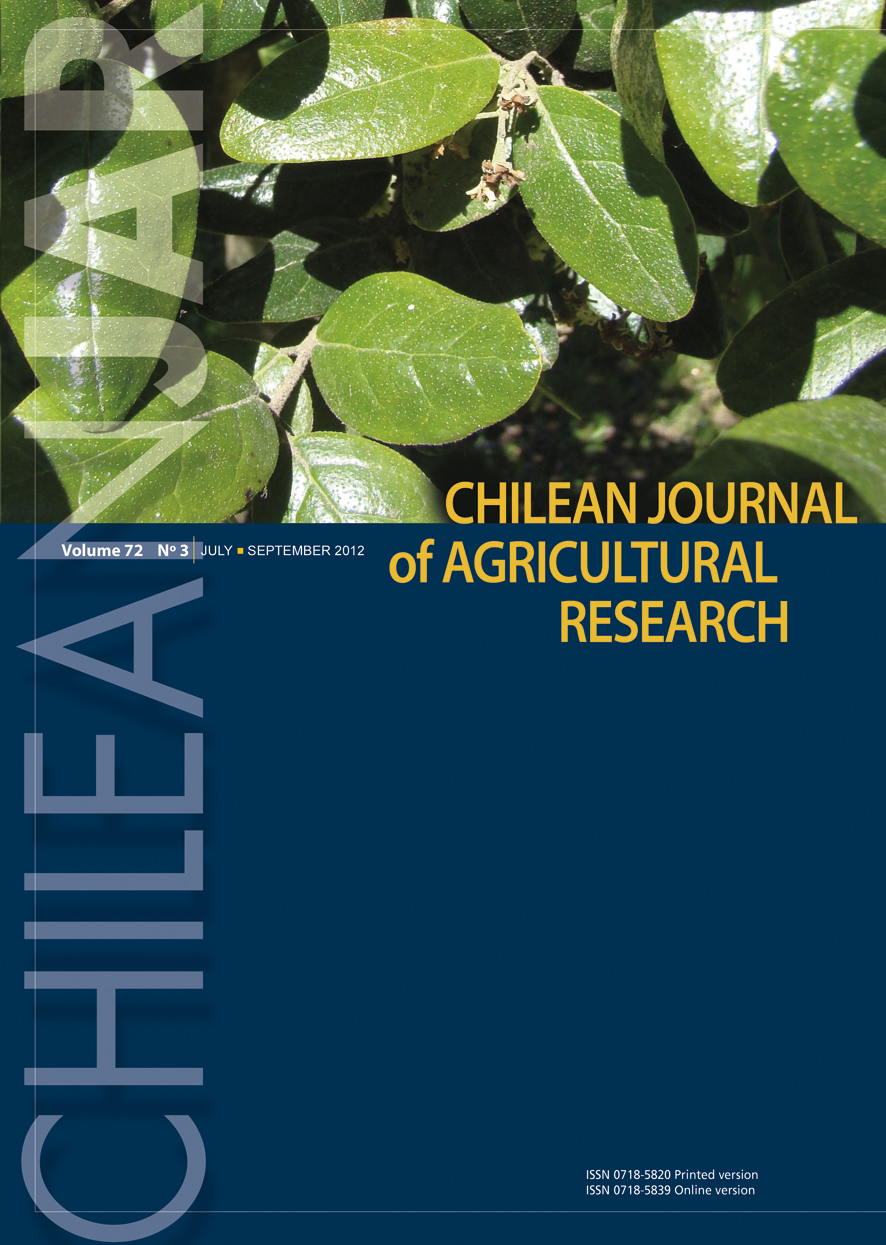
|
Chilean Journal of Agricultural Research
Instituto de Investigaciones Agropecuarias, INIA
ISSN: 0718-5820
EISSN: 0718-5820
Vol. 71, No. 1, 2011, pp. 52-62
|
 Bioline Code: cj11007
Bioline Code: cj11007
Full paper language: English
Document type: Research Article
Document available free of charge
|
|
|
Chilean Journal of Agricultural Research, Vol. 71, No. 1, 2011, pp. 52-62
| en |
Induction of resistance in chickpea (Cicer arietinum L.) against Ascochyta rabiei by applying chemicals and plant extracts
Ghazanfar, M. Usman; Wakil, Waqas & Sahi, Shahbaz Talib
Abstract
Since new fungicides are scarce in the market and because of environmental problems, researchers are now emphasizing other alternatives, such as the genetic potential of plants, resistance against pathogens, and the use of biotic and abiotic agents to develop induced or acquired resistance. We investigated the role of resistance-inducing substances (chemicals and plant extracts) in three chickpea cvs. C-44, Pb-91, and Bittle-98 in field experiments against Ascochyta blight disease. These cultivars were selected on the basis of better yield potential shown in previous experiments. Aqueous solution of salicylic acid (SA) at 0.5, 1.0, and 1.5 mM; acibenzolar-S-methyl (Bion®, ASM) at 0.4, 0.8, and 1.2 mM; and KOH at 25, 50, and 75 mM were applied, whereas Azadirachta indica A. Juss., Datura metel L., and Allium sativum L. plant extracts were applied at 5, 10, and 15%. Disease reduction data was recorded at different intervals from 4 to 14 d after being induced and inoculated with the pathogen. Overall results revealed that significant disease reduction (79.3%) was provided by ASM in the cv. C-44 at 1.2 mM compared with SA, whereas the least significant was KOH. Maximum disease reduction (43.5%) against disease in the plant extracts was observed by applying A. indica leaf extract, but D. metel and A. sativum extracts were not effective. Our findings suggest that enhancing resistance before infecting chickpea plants could be an innovative control method for Ascochyta blight of chickpea.
Keywords
Induced resistance, acibenzolar-S-methyl, salicylic acid, Azadirachta indica, Datura metel.
|
| |
| es |
Inducción de resistencia en garbanzo (Cicer arietinum L.) contra Ascochyta rabiei por la aplicación de productos químicos y extractos vegetales.
Ghazanfar, M. Usman; Wakil, Waqas & Sahi, Shahbaz Talib
Resumen
Debido a la escasez de nuevos fungicidas en el mercado y problemas ambientales, los investigadores están ahora enfatizando otras alternativas, tales como potencial genético de las plantas, resistencia contra patógenos y uso de agentes bióticos y abióticos para el desarrollo de resistencia inducida y adquirida. Investigamos el rol de sustancias inductoras de resistencia (químicos y extractos vegetales) en tres cultivares de garbanzo ‘C-44’, ‘Pb-91’, ‘Bittle-98’, en experimentos de campo contra tizón por Ascochyta. Estos cultivares se seleccionaron basado en el mejor potencial de rendimiento mostrado en experimentos previos. Solución acuosa de ácido salicílico (SA) a 0,5; 1,0; y 1,5 mM, acibenzolar-S-metil (Bion®) a 0,4; 0,8; y 1,2 mM y KOH a 25, 50, y 75 mM se aplicaron mientras los extractos vegetales de Azadirachta indica A. Juss., Datura metel L. y Allium sativum L. se aplicaron a 5, 10, y 15%. Datos de reducción en la enfermedad se registraron con diferentes intervalos desde 4 a 14 d después de inducción e inoculación con el patógeno. Los resultados revelaron que ASM 1,2 mM provocó una reducción significativa de la enfermedad (79,3%) en el cv. C-44 comparado con SA; sin embargo, la menor reducción fue observada para KOH. Entre los extractos vegetales, la máxima reducción de la enfermedad (43,5%) se observó con la aplicación de extracto foliar de A. indica y los extractos de D. metel y A. sativum no fueron efectivos para la reducción de la enfermedad. Los presentes hallazgos sugieren que el aumento de la resistencia antes de la infección de plantas de garbanzo pudo ser un método de control innovador para tizón del garbanzo por Ascochyta.
Palabras-clave
Resistencia inducida, acibenzolar-S-metil, ácido salicílico, Azadirachta indica, Datura metel.
|
| |
© Copyright 2011 Chilean Journal of Agricultural Research.
Alternative site location: http://www.inia.cl
|
|
